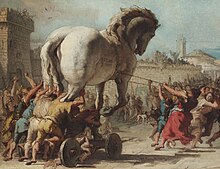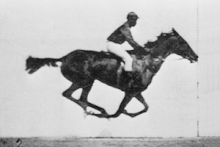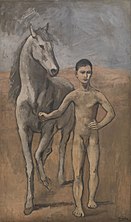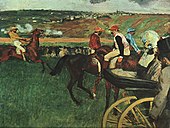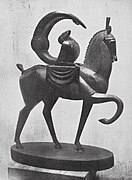
Berthe Marie Pauline Morisot was a French painter and a member of the circle of painters in Paris who became known as the Impressionists.

Georges Braque was a major 20th-century French painter, collagist, draughtsman, printmaker and sculptor. His most notable contributions were in his alliance with Fauvism from 1905, and the role he played in the development of Cubism. Braque's work between 1908 and 1912 is closely associated with that of his colleague Pablo Picasso. Their respective Cubist works were indistinguishable for many years, yet the quiet nature of Braque was partially eclipsed by the fame and notoriety of Picasso.

Paolo Uccello, born Paolo di Dono, was an Italian painter and mathematician who was notable for his pioneering work on visual perspective in art. In his book Lives of the Most Excellent Painters, Sculptors, and Architects, Giorgio Vasari wrote that Uccello was obsessed by his interest in perspective and would stay up all night in his study trying to grasp the exact vanishing point. Uccello used perspective to create a feeling of depth in his paintings. His best known works are the three paintings representing the battle of San Romano, which were wrongly entitled the Battle of Sant'Egidio of 1416 for a long period of time.

Cubism is an early-20th-century avant-garde art movement that revolutionized European painting and sculpture, and inspired related artistic movements in music, literature, and architecture. In Cubist works of art, the subjects are analyzed, broken up, and reassembled in an abstract form—instead of depicting objects from a single perspective, the artist depicts the subject from multiple perspectives to represent the subject in a greater context. Cubism has been considered the most influential art movement of the 20th century. The term cubism is broadly associated with a variety of artworks produced in Paris or near Paris (Puteaux) during the 1910s and throughout the 1920s.

Edgar Degas was a French Impressionist artist famous for his pastel drawings and oil paintings.

Sir Alfred James Munnings, is known as having been one of England's finest painters of horses, and as an outspoken critic of Modernism. Engaged by Lord Beaverbrook's Canadian War Memorials Fund after the Great War, he earned several prestigious commissions, which made him wealthy. Between 1912 and 1914 he was a member of the Newlyn School of artists. His work was part of the art competitions at the 1928 Summer Olympics, the 1932 Summer Olympics, and the 1948 Summer Olympics.
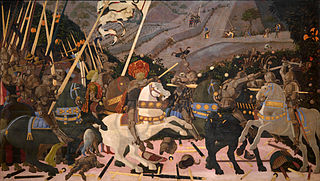
The Battle of San Romano is a set of three paintings by the Florentine painter Paolo Uccello depicting events that took place at the Battle of San Romano between Florentine and Sienese forces in 1432. They are significant as revealing the development of linear perspective in early Italian Renaissance painting, and are unusual as a major secular commission. The paintings are in egg tempera on wooden panels, each over 3 metres long. According to the National Gallery, the panels were commissioned by a member of the Bartolini Salimbeni family in Florence sometime between 1435 and 1460. The paintings were much admired in the 15th century; Lorenzo de' Medici so coveted them that he purchased one and had the remaining two forcibly removed to the Palazzo Medici. They are now divided between three collections, the National Gallery, London, the Galleria degli Uffizi, Florence, and the Musée du Louvre, Paris.

Fauvism is a style of painting and an art movement that emerged in France at the beginning of the 20th century. It was the style of les Fauves, a group of modern artists whose works emphasized painterly qualities and strong colour over the representational or realistic values retained by Impressionism. While Fauvism as a style began around 1904 and continued beyond 1910, the movement as such lasted only a few years, 1905–1908, and had three exhibitions. The leaders of the movement were André Derain and Henri Matisse.
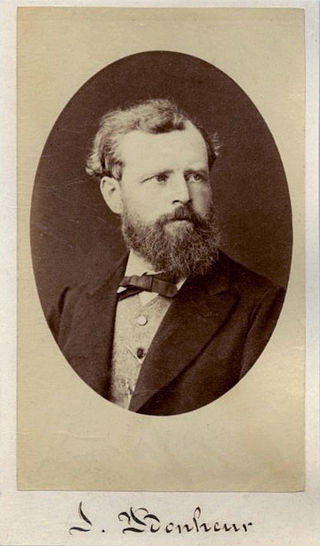
Isidore Jules Bonheur, best known as one of the 19th century's most distinguished French animalier sculptors. Bonheur began his career as an artist working with his elder sister Rosa Bonheur in the studio of their father, drawing instructor Raymond Bonheur. Initially working as a painter, Isidore Jules Bonheur made his Salon debut in 1848.

The Horse Fair is an oil-on-canvas painting by French artist Rosa Bonheur, begun in 1852 and first exhibited at the Paris Salon in 1853. The artist added some finishing touches in 1855. The large work measures 96.25 in × 199.5 in.
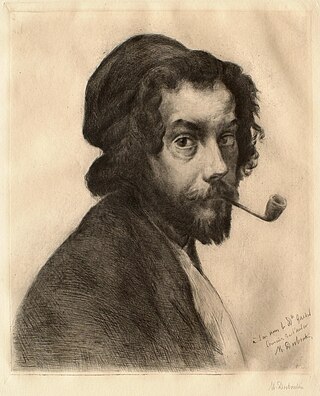
Marcellin Gilbert Desboutin was a French painter, printmaker, and writer. Desboutin always signed himself Baron de Rochefort.

Woman with a Horse is a large oil painting created toward the end of 1911, early 1912, by the French artist Jean Metzinger (1883–1956). The work was exhibited in Paris at the Salon des Indépendants in 1912 and the Salon de la Section d'Or, 1912. The following year La Femme au Cheval was reproduced in The Cubist Painters, Aesthetic Meditations by Guillaume Apollinaire (1913).
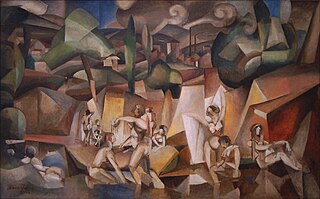
The Bathers {French: Les Baigneuses) is a large oil painting created at the outset of 1912 by the French artist Albert Gleizes. It was exhibited at the Salon des Indépendants in Paris during the spring of 1912; the Salon de la Société Normande de Peinture Moderne, Rouen, summer 1912; and the Salon de la Section d'Or, autumn 1912. The painting was reproduced in Du "Cubisme", written by Albert Gleizes and Jean Metzinger the same year: the first and only manifesto on Cubism. Les Baigneuses, while still 'readable' in the figurative or representational sense, exemplifies the mobile, dynamic fragmentation of form and multiple perspective characteristic of Cubism at the outset of 1912. Highly sophisticated, both in theory and in practice, this aspect of simultaneity would soon become identified with the practices of the Section d'Or group. Gleizes deploys these techniques in "a radical, personal and coherent manner". Purchased in 1937, the painting is exhibited in the permanent collection of the Musée d'Art Moderne de la Ville de Paris.

Colored Landscape with Aquatic Birds is an oil painting created circa 1907 by the French artist and theorist Jean Metzinger. Paysage coloré aux oiseaux aquatiques is a Proto-Cubist work executed in a Post-Divisionist style with a unique Fauve-like palette. Metzinger's broad omnidirectional brushstrokes in the treatment of surfaces render homage to Paul Cézanne, while the luscious subtropical imagery in the painting are an homage to Paul Gauguin and Metzinger's friend Henri Rousseau.

Woman with a Fan is a painting by the French artist Jean Metzinger. The work was exhibited in 1914 at Moderni Umeni, S.V.U. Mánes, Prague. A 1914 photograph taken at the exhibition in Prague was published in the magazine Zlatá Praha showing Woman with a Fan hanging next to another work by Metzinger known as En Canot , 1913. Donated by Mr and Mrs Sigmund Kunstadter in 1959, Woman with a Fan forms part of the permanent collection in Gallery 391B at the Art Institute of Chicago, US.
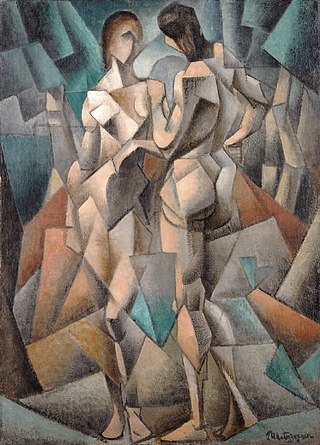
Two Nudes is an early Cubist painting by the French artist and theorist Jean Metzinger. The work was exhibited at the first Cubist manifestation, in Room 41 of the 1911 Salon des Indépendants, Paris. At this exhibition the Cubist movement was effectively launched before the general public by five artists: Metzinger, Gleizes, Le Fauconnier, Delaunay and Léger. This was the first exhibition during which artists, writers, critics and the public at large encountered and spoke about Cubism. The result of the group show is a succès de scandale.

The Circus is an oil on canvas painting by Georges Seurat. It was his last painting, made in a Neo-Impressionist style in 1890–91, and remained unfinished at his death in March 1891. The painting is located at the Musée d'Orsay in Paris.

Les Peintres Cubistes, Méditations Esthétiques, is a book written by Guillaume Apollinaire between 1905 and 1912, published in 1913. This was the third major text on Cubism; following Du "Cubisme" by Albert Gleizes and Jean Metzinger (1912); and André Salmon, Histoire anecdotique du cubisme (1912).

Henri Michel-Lévy, was a French impressionist painter.
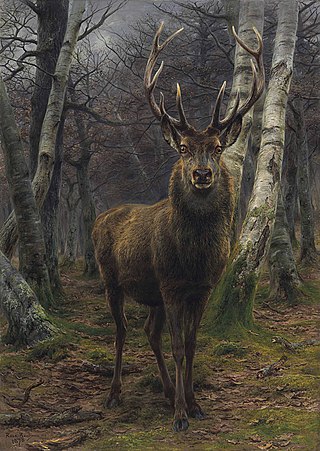
King of the Forest is an 1878 oil on canvas painting by French artist Rosa Bonheur. The work measures 244.8 cm × 175 cm. In the catalogue for an auction sale at Christie's in 2017, it was described as "Perhaps among the most important paintings by the renowned animalier Rosa Bonheur remaining in private hands" and "considered by the artist herself to be one of her masterpieces".








